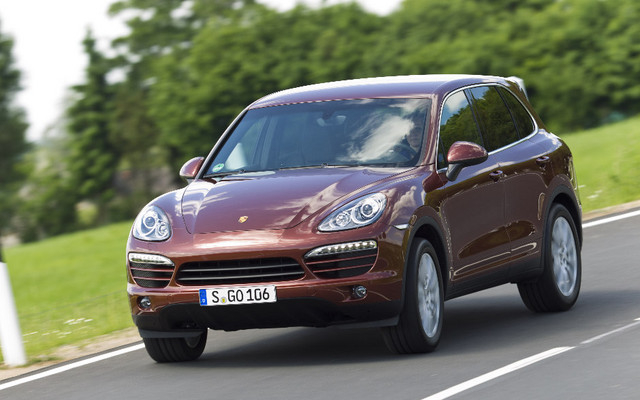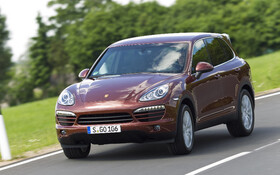Porsche Cayenne V6: The diesel is missing
In most markets, three direct injection V6s are available for the new generation of the Cayenne. First, there’s an updated version of the previously used 3.6-litre engine. Then, there’s a supercharged 3.0-litre engine outfitting the new Cayenne S Hybrid. And, like before, the Cayenne Diesel has a turbocharged 3.0-litre based on the engine of its predecessor. Unfortunately, this little jewel of an engine will not make the trip over to our continent. Some American decision makers determined that Porsche and diesel were not a winning combination. It’s a shame (yes, I know I’m repeating myself) because the V6 diesel is... sublime. If you want one, you can always get a VW Touareg, which shares the Cayenne’s platform and is available with a diesel engine.
More powerful, less fuel-hungry
Ok, so let’s focus on the version with the 3.6-litre V6 that runs on gas. This vehicle has gained power despite the fact that it consumes considerably less fuel. How did Porsche achieve these opposing objectives? Here are the technical details:
For a perfected Cayenne engine, motorists wanted not only a marked reduction in fuel consumption, but also increased power and torque. The addition of 10 horses – bringing it up 300 lbs.-ft. at 3,000 rpm – is the fruit of a combination of measures. The airflow metre has been modified, losses caused by friction inside the engine have been reduced, and the electronic engine management system has been updated. The new airflow meter provides less resistance for air intake, which helps the cylinders fill up. Lighter pistons, new rings and a new method for treating cylinder surfaces have reduced engine weight and interior friction.
New thermal management, variable deceleration fuel cut-off and the automatic Stop-Start function that comes with the new Tiptronic S eight-speed gearbox also contribute to the engine’s efficiency. Equipped with the optional Tiptronic S transmission, the new Cayenne posts a total consumption of 9.9 L/100 km, which is approximately 20% less than the previous model. The factory-standard manual gearbox without automatic Stop-Start consumes 11.2 L/100 km, which is about 10% less than before.
This reworked V6 also received several other improvements. The crankshaft is now made out of drop-forged steel, bringing down the weight while making the engine less rough. They’ve also added an electronic oil gauge that allows you to check your oil levels while the engine is running at low speeds – you don’t even need to open the hood!
Eight – count ’em!
If you think that your car is "up to speed" with six automatic gears, I regret to inform you that it’s two gears behind cutting-edge technology. More and more eight-speed automatic gearboxes are appearing on the market. Not to be left behind, Porsche developed its own transmission of this kind. It’s worth mentioning that the Cayenne powered by the 3.6-litre engine is offered standard with the manual six-speed transmission, whereas all other models come factory-standard with the eight-speed automatic gearbox.
With the new Tiptronic S eight-speed transmission, Porsche offers the Cayenne family a gearbox that will be known for great performances and fast shifting. The transmission crankcase is 20% bigger, allowing it to house two extra overdrive gears. This means that the engine can always operate in an optimal range. In seventh and eighth gears, speed is reduced by 20% respectively, decisively reducing fuel consumption, particularly on long highway drives. For optimal performance on starts, the eight-speed Tiptronic S automatically engages first gear. Top speeds are attained in sixth. Changing gears is 0.15 seconds faster – the measure of driving bliss. These improved shifting times are the result of a newly designed hydraulic control system. But this transmission wasn’t satisfied with faster gear changes and two extra speeds.
The driver can now have influence gearshifts via the accelerator and brake pedals. Fast taps on the accelerator automatically adjust the gearshift points – the driver doesn’t even need to engage the kick-down. Whereas suddenly taking your foot off the pedal (when heading into a corner, for example) will prevent upshifts as the vehicle decelerates. Locking the engaged gear also prevents upshifts on corners. As a result, handling is safer and more stable. During sudden braking, the Tiptronic S gearbox shifts down rapidly, maximizing the engine brake. An incline sensor improves accelerations when going uphill and increases torque from the engine brake when driving downhill.
Like in the past, the driver can choose between two modes: Normal and Sport. In these two base modes, gear shifting is always adapted to driving style. For ultra-sporty handling, a touch of the Sport button changes Tiptronic S settings to the very fast Sport engine mapping. For this kind of driving style and speed, seventh and eighth gears are not engaged, and downshifting when braking results in slower decelerations to facilitate subsequent accelerations. Meanwhile, in Normal mode, the Tiptronic S gearbox allows for more economical driving, reducing fuel consumption with fast upshifts and late downshifts. On the Hybrid version, the transmission features several exclusive settings for power recovery.
You just have to feel it
Well, that sums up the technology. And that’s just the tip of the iceberg! We could write volumes about the new Cayenne and its variants – and we’d still have to leave out some details. But to summarize the V6 engine options, there are: the turbocharged engine on the Cayenne S Hybrid, the 3.0-litre diesel engine in the TDI version (sadly unavailable in North America). And, of course, there’s the gas-run V6 offered on our continent.
The latter offers good accelerations and good start-ups. It may not be as rocket-like as the turbo V8 version, but it’s still pretty impressive. Sprints from 0-100 km/hr take just 8 seconds, which is pretty good considering the vehicle’s size and engine power. And, in case you’re interested, this vehicle’s maximum speed is 230 km/hr!
We tested the model with an eight-speed automatic transmission, which offered exemplary flexibility and smooth handling. However, many may consider the engine grunts and sound levels as the Cayenne’s downfall. To each their own. Personally, I find it adds personality, even if it doesn’t offer the same spectacular performances as the V8 engine.
Unfortunately, we would have been well served with the diesel version, which offers the same acceleration times as the gas version while burning 20% less fuel. Fingers crossed that Porsche management in North America will have a change of heart in the coming months.
That said, the version equipped with the 3.6-litre V6 warrants our interest. It offers impressive road handling, a nearly perfect passenger compartment and reasonable fuel consumption. Plus, the make and model’s prestige is nothing to sneeze at…







